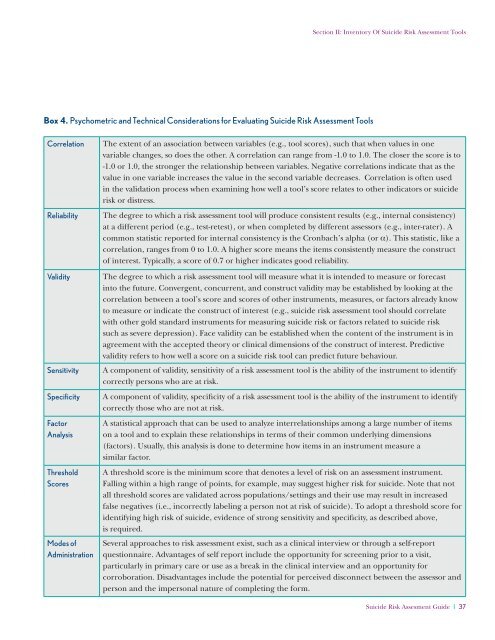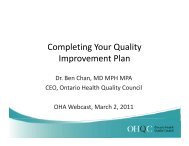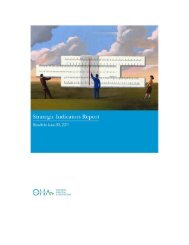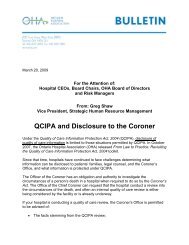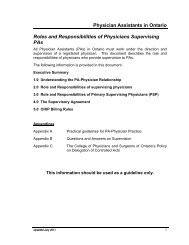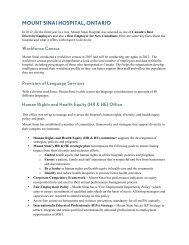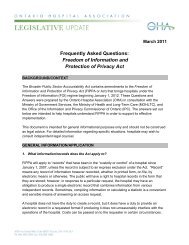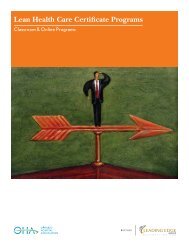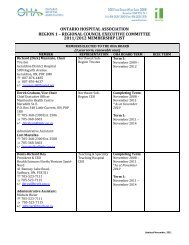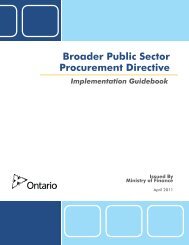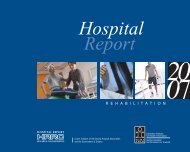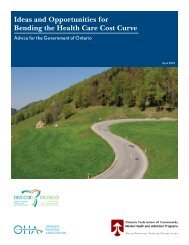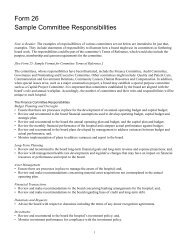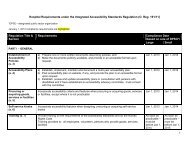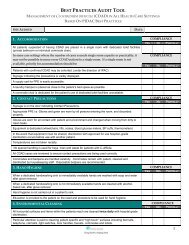Suicide Risk Assessment Guide - Ontario Hospital Association
Suicide Risk Assessment Guide - Ontario Hospital Association
Suicide Risk Assessment Guide - Ontario Hospital Association
Create successful ePaper yourself
Turn your PDF publications into a flip-book with our unique Google optimized e-Paper software.
Box 4. Psychometric and Technical Considerations for Evaluating <strong>Suicide</strong> <strong>Risk</strong> <strong>Assessment</strong> Tools<br />
Section II: Inventory Of <strong>Suicide</strong> <strong>Risk</strong> <strong>Assessment</strong> Tools<br />
Correlation The extent of an association between variables (e.g., tool scores), such that when values in one<br />
variable changes, so does the other. A correlation can range from -1.0 to 1.0. The closer the score is to<br />
-1.0 or 1.0, the stronger the relationship between variables. Negative correlations indicate that as the<br />
value in one variable increases the value in the second variable decreases. Correlation is often used<br />
in the validation process when examining how well a tool’s score relates to other indicators or suicide<br />
risk or distress.<br />
Reliability The degree to which a risk assessment tool will produce consistent results (e.g., internal consistency)<br />
at a different period (e.g., test-retest), or when completed by different assessors (e.g., inter-rater). A<br />
common statistic reported for internal consistency is the Cronbach’s alpha (or α). This statistic, like a<br />
correlation, ranges from 0 to 1.0. A higher score means the items consistently measure the construct<br />
of interest. Typically, a score of 0.7 or higher indicates good reliability.<br />
Validity The degree to which a risk assessment tool will measure what it is intended to measure or forecast<br />
into the future. Convergent, concurrent, and construct validity may be established by looking at the<br />
correlation between a tool’s score and scores of other instruments, measures, or factors already know<br />
to measure or indicate the construct of interest (e.g., suicide risk assessment tool should correlate<br />
with other gold standard instruments for measuring suicide risk or factors related to suicide risk<br />
such as severe depression). Face validity can be established when the content of the instrument is in<br />
agreement with the accepted theory or clinical dimensions of the construct of interest. Predictive<br />
validity refers to how well a score on a suicide risk tool can predict future behaviour.<br />
Sensitivity A component of validity, sensitivity of a risk assessment tool is the ability of the instrument to identify<br />
correctly persons who are at risk.<br />
Specificity A component of validity, specificity of a risk assessment tool is the ability of the instrument to identify<br />
correctly those who are not at risk.<br />
Factor<br />
Analysis<br />
Threshold<br />
Scores<br />
Modes of<br />
Administration<br />
A statistical approach that can be used to analyze interrelationships among a large number of items<br />
on a tool and to explain these relationships in terms of their common underlying dimensions<br />
(factors). Usually, this analysis is done to determine how items in an instrument measure a<br />
similar factor.<br />
A threshold score is the minimum score that denotes a level of risk on an assessment instrument.<br />
Falling within a high range of points, for example, may suggest higher risk for suicide. Note that not<br />
all threshold scores are validated across populations/settings and their use may result in increased<br />
false negatives (i.e., incorrectly labeling a person not at risk of suicide). To adopt a threshold score for<br />
identifying high risk of suicide, evidence of strong sensitivity and specificity, as described above,<br />
is required.<br />
Several approaches to risk assessment exist, such as a clinical interview or through a self-report<br />
questionnaire. Advantages of self report include the opportunity for screening prior to a visit,<br />
particularly in primary care or use as a break in the clinical interview and an opportunity for<br />
corroboration. Disadvantages include the potential for perceived disconnect between the assessor and<br />
person and the impersonal nature of completing the form.<br />
<strong>Suicide</strong> <strong>Risk</strong> Assesment <strong>Guide</strong> I 37


